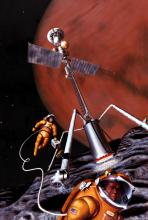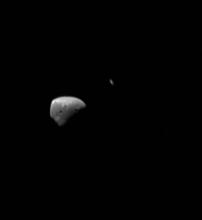Listen to today's episode of StarDate on the web the same day it airs in high-quality streaming audio without any extra ads or announcements. Choose a $8 one-month pass, or listen every day for a year for just $30.
You are here
Mars and Saturn
The planets Mars and Saturn don’t have a lot in common. Mars is small, dense, and rocky. Saturn probably has a rocky core, but most of it is made up of gas. So while Saturn is many times larger than Mars, it’s the “fluffiest” planet in the solar system.
One possible similarity, though, is rings. Saturn is encircled by wide, beautiful rings. Mars doesn’t have any rings today, but it could have had them in the distant past — and might again millions of years in the future.
Saturn’s rings probably formed when a small moon was pulverized. The moon might have passed too close to Saturn and was pulled apart by Saturn’s gravity. Or it might have been shattered by a collision with another body.
Mars could have been smacked by a smaller object billions of years ago, creating its own rings. Some of that debris might have coalesced to form the planet’s moons, Phobos and Deimos.
Phobos is only 3700 miles above the Martian surface. And it’s sliding closer — by about six feet per century. In 50 million years or so, it’ll either crash into Mars, or be pulled apart by the planet’s gravity — creating a new ring.
Mars and Saturn are forming a tight pair in the early morning sky. They’re low in the southeast at first light, to the lower left of brilliant Jupiter. Tomorrow, Mars will stand a little below Saturn. After that, Mars will slide away from Saturn. In a few days, that’ll break up the pairing of these quite-different siblings.
Script by Damond Benningfield





